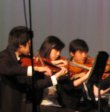 String and chamber orchestras play to spring’s delight
String and chamber orchestras play to spring’s delight
The Spring Orchestra Concert could safely be the first concert of the year that still saw sunshine outside when it started. It is a tradition for the Kennedy Middle School Advanced Orchestra to share the bill with the MVHS in the annual spring concert. The three groups of student performers presented a refreshing selection of mostly modern music to a three-quarters-full house on April 29.
The KMS students opened with a rather shaky start that was not the result of the vibrato on the opening note. George Frideric Handel’s "Overture from Il Pastor Fido", arranged by music director Bob Lipton of the KMS orchestra, had equal parts lyricism and lively rhythm but the performance failed to express either part convincingly. The effort of stronger players in the front half of the sections was evident but as a whole, the consistency of the players’ skill levels resulted in frequent untidiness and acoustic incoherence.
The subsequent program was performed with more ease as the players became more comfortable on stage. "Emperor Waltz" by "The Waltz King" Johann Strauss II was a delightful and familiar piece that was not uncommon at a garden party in an Audrey Hepburn period film.The first third of the night ended with the Brazilian choro virtuoso "Tico Tico" by Zequinha del Abreu. In the tradition of Lipton’s rather unconventional style of music arrangement, the players tapped and plucked their instrument playfully to lend a festive spirit in the finale of their program.
 The middle-schoolers then joined the audience of mostly parents and siblings while the MVHS String Orchestra settled on stage. Music director John Galli felt the orchestra was up for a challenge when he selected Ralph Vaughan Williams’s "Concerto Grosso". The 15-minute symphony of string sounds was set up to be led by soloists in the front chairs of each section and accompanied by the rest of the orchestra. The result was a rich combination of string sounds that captivated from beginning to end. Each of the first five movements started on the low register, then gradually built up to a climax where multiple layers interacted to manipulate the dynamics of musical expressions, then returned to the sustained low harmony to end. The effectiveness of the interaction was most evident in the fifth movement, "March", in which cello and bass replicated a marching rhythm usually played by brass or percussion in a symphonic orchestra.
The middle-schoolers then joined the audience of mostly parents and siblings while the MVHS String Orchestra settled on stage. Music director John Galli felt the orchestra was up for a challenge when he selected Ralph Vaughan Williams’s "Concerto Grosso". The 15-minute symphony of string sounds was set up to be led by soloists in the front chairs of each section and accompanied by the rest of the orchestra. The result was a rich combination of string sounds that captivated from beginning to end. Each of the first five movements started on the low register, then gradually built up to a climax where multiple layers interacted to manipulate the dynamics of musical expressions, then returned to the sustained low harmony to end. The effectiveness of the interaction was most evident in the fifth movement, "March", in which cello and bass replicated a marching rhythm usually played by brass or percussion in a symphonic orchestra.
At times the overlapping and undercutting part of the sections sounded muddled, but that could be due to the inherent nontraditional sense of harmony of the music and the acoustic effect of the auditorium, which tended to amplify echoes. But up until the end, the solid combination of skillful soloists and supportive accompaniment stretched their capacity to more than a conventionally lyrical classical repertoire.
The gem of the night was the performance by the Chamber Orchestra, which, after a shy bow by the concertmaster junior Tom Cheng, began Anton Dvorak’s "Serenade in E Op. 22", a personal favorite of Galli. The serenade was originally a back-up piece to the orchestra’s earlier performance of "The Four Seasons" by Vivaldi. It was officially rehearsed for three weeks prior to this concert.
The Chamber Orchestra, the apparently most advanced group of the three, gave an impressionable performance, most notable for the seamless coordination between each section. Each part of the orchestration connected dynamically and smoothly with each other which, in turn, resulted a pleasing unity vital to the lyricism of the music. The concert ended on a swift but conclusive run of notes. Not only did Galli thank the audience for attending, the audience had the students and Galli to thank too for an unexpected introduction to a new dimension of string music.





